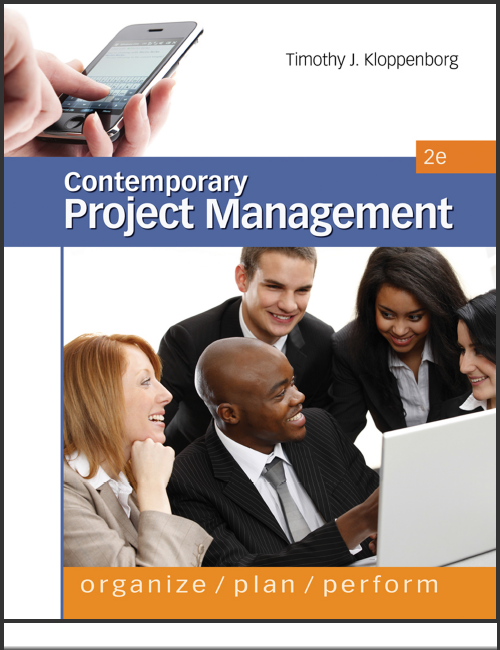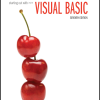Test Bank for Contemporary Project Management 2nd edition by Timothy Kloppenborg 9780538477024 0538477024
$70.00 Original price was: $70.00.$35.00Current price is: $35.00.
Instant download (Test Bank) Contemporary Project Management 2nd Ediitn by Kloppenborg after payment
Contemporary Project Management 2nd edition by Timothy Kloppenborg – Ebook PDF Instant Download/Delivery:9780538477024 0538477024

Full dowload Contemporary Project Management 2nd edition after payment
Product details:
• ISBN 10:0538477024
• ISBN 13:9780538477024
• Author:Timothy Kloppenborg
Bound with envelope containing access code.
Contemporary Project Management 2nd Table of contents:
Part 1. Organizing Projects
Chapter 1. Introduction to Project Management
1.1. What Is a Project?
1.2. History of Project Management
1.3. How Can Project Work Be Described?
1.3a. Projects versus Operations
1.3b. Soft Skills and Hard Skills
1.3c. Authority and Responsibility
1.3d. Project Life Cycle
1.4. Understanding Projects
1.4a. Project Management Institute
1.4b. Project Management Body of Knowledge (PMBOK Guide 6e)
1.4c. The PMI Talent Triangle
1.4d. Selecting and Prioritizing Projects
1.4e. Project Goals and Constraints
1.4f. Defining Project Success and Failure
1.4g. Using Microsoft Project® to Help Plan and Measure Projects
1.4h. Types of Projects
1.4i. Scalability of Project Tools
1.5. Project Roles
1.5a. Project Executive-Level Roles
1.5b. Project Management-Level Roles
1.5c. Project Associate-Level Roles
1.6. PMBOK Guide 7e
Standard for Project Management ANSI/PMI 99-001-2021
PMBOK Guide 7e
1.7. Agile Introduction
1.7a. Agile Terms Used in an Introduction to Project Management
1.8. Overview of the Book
1.8a. Part 1: Organizing and Initiating Projects
1.8b. Part 2: Leading Projects
1.8c. Part 3: Planning Projects
1.8d. Part 4: Performing Projects
Summary
Key Terms Consistent with PMI Standards and Guides
Key Terms Consistent with Agile Practice
Chapter Review Questions
Discussion Questions
PMP Exam Study Questions
Integrated Example Projects
Semester Project Instructions
References
Chapter 2. Project Selection and Prioritization
2.1. Strategic Planning Process
2.1a. Strategic Analysis
2.1b. Guiding Principles
2.1c. Strategic Objectives
2.1d. Flow-Down Objectives
2.2. Define Portfolio Management
2.2a. Portfolios
2.2b. Programs
2.2c. Projects and Subprojects
2.3. Perform Portfolio Management
2.3a. Assessing an Organization’s Ability to Perform Projects
2.3b. Identifying Potential Projects
2.3c. Using a Cost-Benefit Analysis Model to Select Projects
2.3d. Using a Scoring Model to Select Projects
2.3e. Prioritizing Projects
2.3f. Resourcing Projects
2.4. Securing Projects
2.4a. Identify Potential Project Opportunities
2.4b. Determine Which Opportunities to Pursue
2.4c. Prepare and Submit a Project Proposal
2.4d. Negotiate to Secure the Project
2.5. PMBOK 7e Guide
2.5a. Stakeholders
2.5b. Team
2.5c. Development Approach
2.5d. Planning
2.5e. Uncertainty
2.6. Agile Project Selection
2.6a. Agile Terms Used in an Introduction to Project Selection and Prioritization
Summary
Key Terms Consistent with PMI Standards and Guides
Key Terms Consistent with Agile Practice
Chapter Review Questions
Discussion Questions
PMP Exam Study Questions
Exercises
Integrated Example Projects
Semester Project Instructions
References
Chapter 3. Chartering Projects
3.1. What Is a Project Charter?
3.2. Why Is a Project Charter Used?
3.3. When Is a Charter Needed?
3.4. Typical Elements in a Project Charter
3.4a. Title
3.4b. Scope Overview
3.4c. Business Case
3.4d. Background
3.4e. Milestone Schedule with Acceptance Criteria
3.4f. Risks, Assumptions, and Constraints
3.4g. Resource Estimates
3.4h. Stakeholder List
3.4i. Team Operating Principles
3.4j. Lessons Learned
3.4k. Signatures and Commitment
3.5. Constructing a Project Charter
3.5a. Scope Overview and Business Case Instructions
3.5b. Background Instructions
3.5c. Milestone Schedule with Acceptance Criteria Instructions
3.5d. Uncertainty Instructions
3.5e. Resources Needed Instructions
3.5f. Stakeholder List Instructions
3.5g. Team Operating Principles Instructions
3.5h. Lessons Learned Instructions
3.5i. Signatures and Commitment Instructions
3.6. Ratifying the Project Charter
3.7. PMBOK Guide 7e
3.7a. Stakeholders
3.7b. Team
3.7c. Development Approach and Life Cycle
3.7d. Planning
3.7e. Measurement
3.7f. Uncertainty
3.8. Agile Projects and Charters
3.8a. Agile Terms Used in Chartering Projects
3.8b. Agile
3.9. Starting a Project Using Microsoft Project
3.9a. MS Project Introduction
3.9b. Setting up Your First Project
3.9c. Define Your Project
3.9d. Create a Milestone Schedule
Summary
Key Terms Consistent with PMI Standards and Guides
Key Terms Consistent with Agile Practice
Chapter Review Questions
Discussion Questions
PMP Exam Study Questions
Exercises
Integrated Example Projects
Semester Project Instructions
References
Part 2. Leading Projects
Chapter 4. Organizational Capability: Structure, Culture, and Roles
4.1. Types of Organizational Structures
4.1a. Functional
4.1b. Projectized
4.1c. Matrix
4.2. Organizational Culture and Its Impact on Projects
4.2a. Culture of the Parent Organization
4.2b. Project Cultural Norms
4.3. Project Life Cycle
4.3a. Define-Measure-Analyze-Improve-Control (DMAIC) Model
4.3b. Research and Development (R&D) Project Life Cycle Model
4.3c. Construction Project Life Cycle Model
4.4. Traditional Project Executive Roles
4.4a. Steering Team
4.4b. Sponsor
4.4c. Customer
4.4d. Chief Projects Officer/Project Management Office
4.5. Traditional Project Management Roles
4.5a. Functional Manager
4.5b. Project Manager
4.5c. Facilitator
4.6. Traditional Project Team Roles
4.6a. Core Team Members
4.6b. Subject Matter Experts
4.7. PMBOK Guide 7e
4.7a. Team
4.7b. Development Approach and Life Cycle
4.7c. Project Work
4.7d. Tailoring
4.8. Agile Projects and Organizational Capability
4.8a. What Is Agile?
4.8b. Agile Terms Used in Organizational Capability
4.8c. Agile Manifesto Principles to Cover
4.8d. Why Use Agile?
4.8e. What Is an Agile Mindset?
4.8f. What Is Needed for Agile to Be Successful?
4.8g. What Is an Agile Project Life Cycle?
4.8h. What Are the Key Roles in Agile Projects?
Summary
Key Terms Consistent with PMI Standards and Guides
Key Terms Consistent with Agile Practice
Chapter Review Questions
Discussion Questions
PMP Exam Study Questions
Exercises
Integrated Example Projects
Semester Project Instructions
References
Chapter 5. Leading and Managing Project Teams
5.1. Acquire Project Team
5.1a. Pre-Assignment of Project Team Members
5.1b. Negotiation for Project Team Members
5.1c. On-Boarding Project Team Members
5.2. Develop Project Team
5.2a. Stages of Project Team Development
5.2b. Characteristics of High-Performing Project Teams
5.2c. Assessing Individual Member Capability
5.2d. Assessing Project Team Capability
5.2e. Building Individual and Project Team Capability
5.2f. Establishing Project Team Ground Rules
5.3. Manage Project Team
5.3a. Project Manager Power and Leadership
5.3b. Assessing Performance of Individuals and Project Teams
5.3c. Project Team Management Outcomes
5.4. Relationship Building Within the Core Team
5.5. Managing Project Conflicts
5.5a. Sources of Project Conflict
5.5b. Conflict-Resolution Process and Styles
5.5c. Negotiation
5.6. Communication Needs of Global and Virtual Teams
5.6a. Virtual Teams
5.6b. Cultural Differences
5.6c. Countries and Project Communication Preferences
5.7. PMBOK Guide 7e
5.7a. Team
5.7b. Stakeholders
5.7c. Development Approach
5.7d. Planning
5.7e. Delivery
5.7f. Measurement
5.7g. Uncertainty
5.8. Agile Project Teams
5.8a. Agile Terms Used in Leading and Managing Project Teams
Summary
Key Terms Consistent with PMI Standards and Guides
Key Terms Consistent with Agile Practice
Chapter Review Questions
Discussion Questions
PMP Exam Study Questions
Integrated Example Projects
Semester Project Instructions
References
Chapter 6. Stakeholder Analysis and Communication Planning
6.1. Identify Stakeholders
6.1a. Find Stakeholders
6.1b. Analyze Stakeholders
6.1c. Document Stakeholders
6.2. Plan Stakeholder Engagement
6.2a. Creating a Stakeholder Engagement Assessment Matrix
6.2b. Planning to Build Relationships with Stakeholders
6.3. Manage Stakeholder Engagement
6.4. Monitor Stakeholder Engagement
6.5. Plan Communications Management
6.5a. Purposes of a Project Communications Plan
6.5b. Communications Plan Considerations
6.5c. Communications Matrix
6.5d. Manage Project Knowledge
6.6. Manage Communications
6.6a. Determine Project Information Needs
6.6b. Establish Information Retrieval and Distribution System
6.6c. Project Meeting Management
6.6d. Issues Management
6.7. PMBOK Guide 7e
6.7a. Stakeholders
6.7b. Team
6.7c. Planning
6.7d. Delivery
6.7e. Measurement
6.8. Agile Projects
6.8a. Agile Terms Used in Stakeholder Analysis and Communication Planning
6.8b. Agile
Summary
Key Terms Consistent with PMI Standards and Guides
Key Terms Consistent with Agile Practice
Chapter Review Questions
Discussion Questions
PMP Exam Study Questions
Integrated Example Projects
Semester Project Instructions
References
Part 3. Planning Projects
Chapter 7. Holistic Scope Planning
7.1. Plan Scope Management
7.2. Collect Requirements
7.2a. Ensure Clarity of Objectives
7.2b. Gather Stakeholder Input and Needs
7.2c. Define Needs as Requirements
7.3. Define Scope
7.3a. Reasons to Define Scope
7.3b. How to Define Scope
7.4. Work Breakdown Structure (WBS)
7.4a. What Is the WBS?
7.4b. Why Use a WBS?
7.4c. WBS Formats
7.4d. Work Packages
7.4e. How to Construct a WBS
7.5. Establish Change Control
7.6. PMBOK Guide 7e
7.6a. Team
7.6b. Development Approach
7.6c. Planning
7.6d. Delivery
7.6e. Measurement
7.6f. Uncertainty
7.7. Agile Projects
7.7a. Agile Terms Used in Holistic Scope Planning
7.8. Using Microsoft Project for Work Breakdown Structures
7.8a. Set up a WBS in MS Project
Summary
Key Terms Consistent with PMI Standards and Guides
Key Terms Consistent with Agile Practice
Chapter Review Questions
Discussion Questions
PMP Exam Study Questions
Exercises
Integrated Example Projects
Semester Project Instructions
References
Chapter 8. Scheduling Projects
8.1. Plan Schedule Management
8.2. Purposes of a Project Schedule
8.3. Historical Development of Project Schedules
8.4. How Project Schedules Are Limited and Created
8.5. Define Activities
8.6. Sequence Activities
8.6a. Leads and Lags
8.6b. Alternative Dependencies
8.7. Estimate Activity Duration
8.7a. Problems and Remedies in Duration Estimating
8.7b. Learning Curves
8.8. Develop Project Schedules
8.8a. Two-Pass Method
8.8b. Enumeration Method
8.9. Uncertainty in Project Schedules
8.9a. Program Evaluation and Review Technique
8.9b. Monte Carlo Simulation
8.10. Show the Project Schedule on a Gantt Chart
8.11. PMBOK Guide 7e
8.11a. Team
8.11b. Development Approach
8.11c. Planning
8.11d. Delivery
8.11e. Measurement
8.11f. Uncertainty
8.12. Schedules for Agile Projects
8.12a. Agile Terms
8.13. Using Microsoft Project for Critical Path Schedules
8.13a. Set Up the Project Schedule
8.13b. Build the Network Diagram and Identify the Critical Path
Summary
Key Terms Consistent with PMI Standards and Guides
Key Terms Consistent with Agile Practice
Chapter Review Questions
Discussion Questions
Exercises
PMP Exam Study Questions
Integrated Example Projects
Semester Project Instructions
References
Chapter 9. Resourcing and Accelerating Projects
9.1. Abilities Needed When Resourcing Projects
9.1a. The Science and Art of Resourcing Projects
9.1b. Considerations When Resourcing Projects
9.1c. Activity-versus Resource-Dominated Schedules
9.2. Estimate Resource Needs
People also search for Contemporary Project Management 2nd:
contemporary project management
contemporary project management 4th edition pdf
contemporary project management 5th edition pdf
contemporary project management 4th edition
traditional and contemporary project management methods


